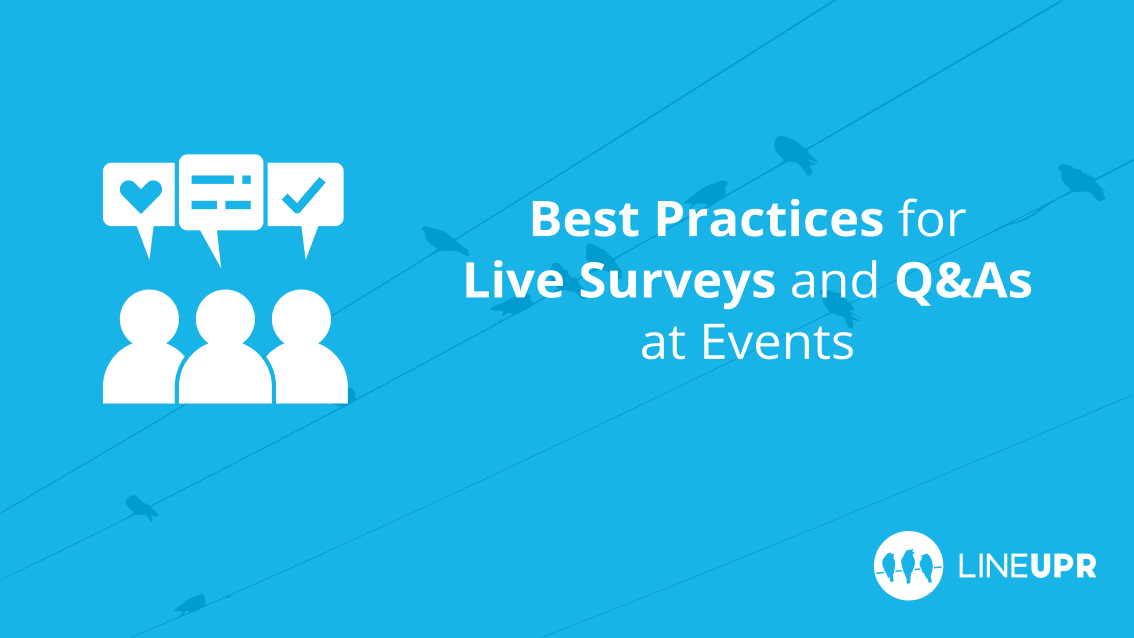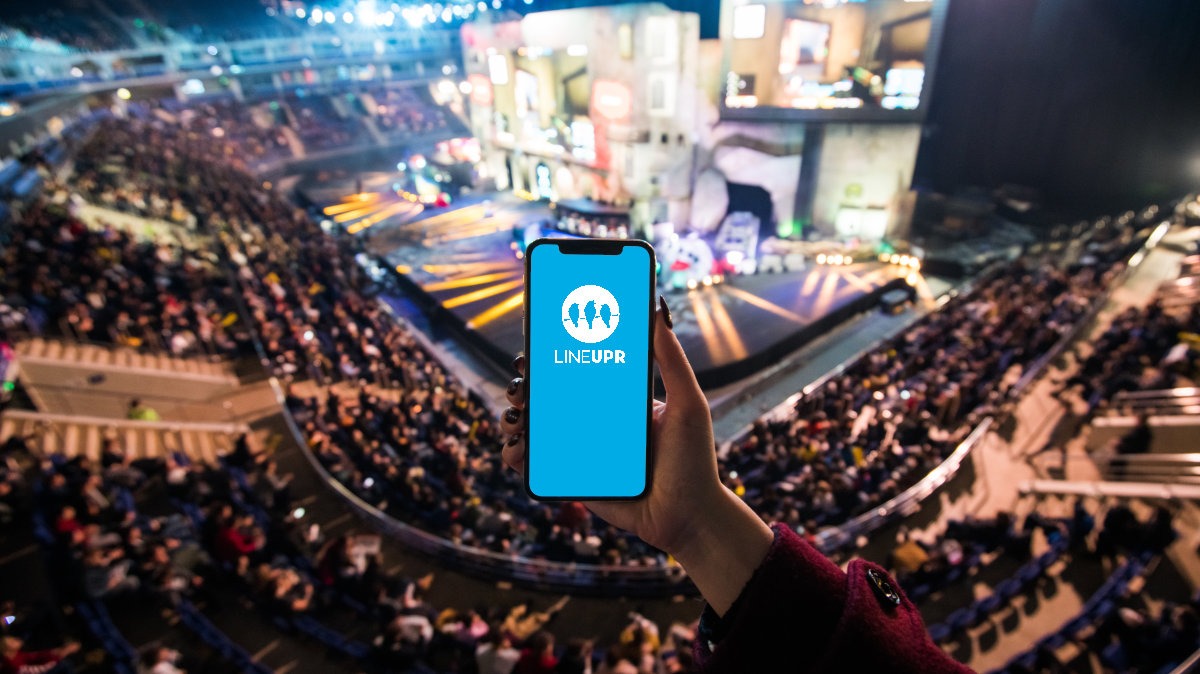Reading time: 5 minutes
Surveys and live polls are a very important topic on our blog. They are used hundreds of times each day in our apps. After exploring why events should use surveys 4 weeks ago, today’s topic is best practices. We’ll tell you what you should be aware of when dealing with surveys, which types of questions we provide, and a step-by-step guide to the most popular surveys at events.
What You Should Pay Attention To
Please only ask relevant questions. Surveys are not an end in themselves, and participants can be annoyed pretty quickly if the questions seem nonsensical. Such an impression is often dull and participants will use your surveys less.
If you want to integrate your speakers into the surveys or to relate them to program points, then inform the speakers in advance about it. Nothing is more unpleasant than being approached about something that you are integrated in, but have no idea about.
If you integrate surveys, for example, live surveys, into individual sessions then everyone on the stage should know in advance about how the process will go. This includes being able to explain to participants why and how the survey can be answered with the app. Also, where the results will be published and what will happen to them.
Create surveys in the language of your target audience. This is especially important when using foreign words. Participants should never have trouble understanding the questions.
Frequently Used Question Types
LineUpr offers you 5 different types of questions. In this article, you will learn exactly how to you use these in your app.
Ranking Questions
If you want your participants to rate something, use the star rating. You ask the questions and the participants can answer based on a star scale.
Examples:
- How did you like the keynote?
- How do you rate our use of event technology? (1 not good, 5 very good)
- On a scale of 1 – 5, how did you like our location?
Single Choice Questions
If you want to give the participants several answer options to choose from, then single choice questions are well suited for this. Here, the participants can select only one of the possible answers.
Examples:
- Should we use an event app again next year? (Yes; No; Doesn’t matter)
- Which theme tracks were the most interesting for you? (IoT; Automotive; Healthcare)
- How many new contacts did you make at the event? (0; 1-5; 6-15; 15-30; more than 30)
Multiple Choice Questions
In contrast to the single choice questions, participants can choose from several possible answer options. This is very suitable for questions in which a participant cannot commit 100% to an answer.
Examples:
- Which features of the event app did you use? (Directions, list of participants, program plan, individual program, favorites, surveys)
- Which theme tracks did you attend? (IoT; Automotive; Healthcare)
Open Free Text Questions
This type is great for questions to which you do not know the answers to, or for which you want to use to know more about the participants. Here the participants have access to a text field where they can enter their answers.
Examples:
- Which speakers do you want to see at our next event?
- What is the biggest challenge for you with the digitalization of events?
- What will you remember most about our event?
Step-By-Step Guide to the Most Popular Surveys
Questions to the Speakers (Live Q&As)
You should define in advance who will take over the moderation of the live Q&As and how they will run. Should the questions be published live or does the moderator select individual questions and read them out?
Test the session before to check if the technology works as planned and shortly go through the process with two questions. Everyone involved should be trained in using the app and the presentation medium. If the moderator, for example, reads the questions, then a tablet is best suited for this.
The moderator must be informed about the complete process. He should also know and explain how attendees can enter questions through the app.
At the beginning of the session, show a slide explaining how participants can ask questions through the app. A QR code is a great way to directly lead to the survey.
For safety reasons, prepare a few starting questions and a little intro until the first questions arrive. No matter how fast the technology is today, the participants will still need a few seconds to type the first questions.
Live Polls During a Session
Inform the participants at the beginning of the session how and when the live polls will be used. Remember, for people to do something, they need to be convinced by it first. So give them a reason to participate.
It is a good idea to give participants a brief explanation of how to use the app to participate in surveys.
The speakers must also be informed about the entire process. Preferably, the questions come directly from them and the results are integrated into the presentation.
When starting the live polls, the questions should appear on a slide. It is certainly not a hindrance if the speaker additionally reads the questions aloud. Another mention of how voting can be done is also great.
Since it may take a few seconds for the results to arrive, the moderator should come up with a small bridge for it. Of course, he can also wait for the results. A few seconds can be a treat for some participants.
The incoming answers for the poll should definitely be presented live. First, the moving bars provide a wow-effect in the audience and secondly, even the skeptical participants are still encouraged to join in (keyword: peer pressure).
Finally, the speaker should definitely integrate the results into the presentation or at least briefly discuss them. Otherwise, the impression that the poll does not really matter to the speaker is conveyed.
Feedback on Presentations and Individual Sessions
At the end of the session, the speaker should definitely point out the evaluation of the program point with the event app.
He should explain how the participants can concretely rate him with the app. Here he can also work with a standardized slide that shows all steps and maybe also contains a QR code or link to the program point.
It also makes sense to give participants 2 minutes to answer the feedback survey at the end of the session. When people are immediately out of the door and on the way to the next session, then the feedback is quickly forgotten.
Feedback Surveys About the Event
When your event is coming to an end and the last session starts, then it’s time to point out the feedback survey for the whole event.
Here you should work with a slide that explains how to answer this survey using the event app. Be sure to explain what you intend to do with the feedback and that you want to continually improve your event for the benefit of the participants.
At the same time, you can send your participants an e-mail with a link to the survey. This can also be combined with the final mail after the event.
This quite generally applies to all feedback surveys: Only implementation leads to success! Please use the feedback to improve your events. If attendees visit your events over a period of several years and complain about the same problem every year and nothing happens, they will eventually stop participating in your feedback surveys. It doesn’t change anything anyway.
What You Should Have Learned
In this article, we explained how to integrate surveys into your event. First, it was about what you should generally consider when using surveys. In the middle, we then dealt with the most frequently used question types and presented you with suitable examples. Finally, we gave you a step-by-step guide on how to best implement the most popular surveys and what to pay attention to.
“Poll” Icon created by Gregor Cresnar from “the Noun Project“.




